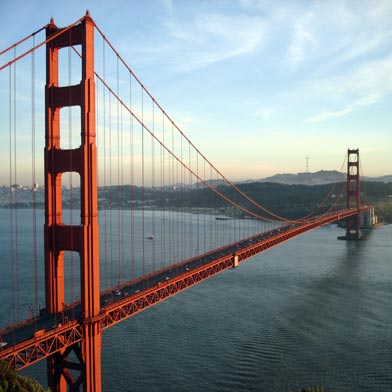 Facing a nearly $100 million budget shortfall over the next five years, the Golden Gate Bridge, Highway and Transportation District board has had to make some tough budget choices on how San Francisco’s most famous landmark operates. One such decision: to completely eliminate Golden Gate Bridge toll-takers in favor of an electronic system. How will an all-electronic system work for travelers used to paying a cash toll? Even the Bridge officials don’t seem to know for sure.
Facing a nearly $100 million budget shortfall over the next five years, the Golden Gate Bridge, Highway and Transportation District board has had to make some tough budget choices on how San Francisco’s most famous landmark operates. One such decision: to completely eliminate Golden Gate Bridge toll-takers in favor of an electronic system. How will an all-electronic system work for travelers used to paying a cash toll? Even the Bridge officials don’t seem to know for sure.
The change in toll taking, which could happen as soon as September 2012, is expected to save the District about $16 million over the next 10 years.
Public Affairs Director Mary Currie told the Appeal that while one primary factor behind the shift is economic, another is largely cultural.
“There were two main reasons for the switch,” Currie said. “One was the financial savings. The other is that this is the way of the future in the tolling industry. In the next 10-15 years there will be very little manual toll collection. This is what’s happening in various locations around the country and around the world.”
They are also hoping that all-electronic tolling will alleviate the daily backup at the toll plaza caused by cars moving in and out of the FasTrack-only lanes.
The change, while significant, won’t affect the majority of drivers. A little over two thirds of whom who use the bridge are already on the FasTrak system–for them everything will stay exactly the same, including the current discount for using FasTrak instead of other payment methods.
The biggest change, and the most questions, are about what will happen for people who typically pay cash tolls.
For locals and those driving their own car, it’s fairly simple: drivers can register their license plates with the district and have the toll automatically charged to their credit card. If drivers don’t register their plates, the system will simply take a picture of their car and mail them a bill.
A picture is already taken of the license plate of every car crossing the bridge, even those using FasTrak. These pictures are used as backups in case there’s an error with the transponders. The bridge will be upgrading to new, more accurate camera technology when it switches over to the new system, Currie says.
There are also plans, Currie says, to create a dedicated carpool lane so carpooling drivers can still receive their discount.
Officials aren’t worried about people abusing the new system by ignoring the bills because there’s already a three-tiered notification system in place for billing that they will tap into. If the offending party doesn’t pay after their third notice, collection of the fine will be handled by the DMV. Delinquents won’t be able to register their cars unless they pay up.
Cars with dealer plates will be on the “honor system” and bridge officials say they are working with the state legislature to shorten the amount of time a car is allowed to be on the road with temporary dealer plates.
While this system seems straightforward enough, it’s doubtlessly going to be confusing for many Bay Area residents and visitors.
“We’re developing a comprehensive plan,” says Currie. “All-electronic tolling will be challenging in a number of ways. People who use it on a daily basis will be no problem, but there will be some confusion because different Bay Area bridges will have different systems in place.”
To combat any confusion, the district plans on rolling out a comprehensive education campaign around the shift. “The greater outreach will be working with rental car companies and tourist industries,” says Currie. “That’s an education that’s going to go on indefinitely.” After the change, rental cars will come with the standard option to pre-pay bridge tolls.
While the basic structure of the system appears solid, some serious logistical issues remain–most of which revolve around car shares and rentals.
At present, Currie says no decisions have been made on how to handle car sharing programs like Zipcar and City CarShare. Additionally, there are no procedures in place to prevent gouging by car rental companies because the district has no control over their pricing policies.
Most car rental companies charge a standard daily fee for transponders (for example, Avis charges $2.50/day and $10/week) plus the cost of the tolls accumulated by drivers.
However, if drivers don’t opt for a transponder, there’s nothing to stop companies from gouging customers every time cross the bridge, Currie admits
Here’s another tricky example: what if someone rents a U-Haul to move from Seattle to San Francisco? What happens when they cross the bridge? It’s doubtful that a U-Haul office two states away will be fully aware of the particularities of the Golden Gate Bridge’s tolling system. Will U-Haul get the bill and then mail it to the now long-gone traveler? Or is this an expense that the district, or U-Haul for that matter, will just have to eat? Currie says that since they’re still in the planning stages, these are the kind of details that still need to be worked out.
Do you have any questions or concerns about getting rid of the toll-takers in favor of an all-electronic system? If so, leave them in the comments and we’ll look into getting them answered.
Want more news, sent to your inbox every day? Then how about subscribing to our email newsletter? Here’s why we think you should. Come on, give it a try.









